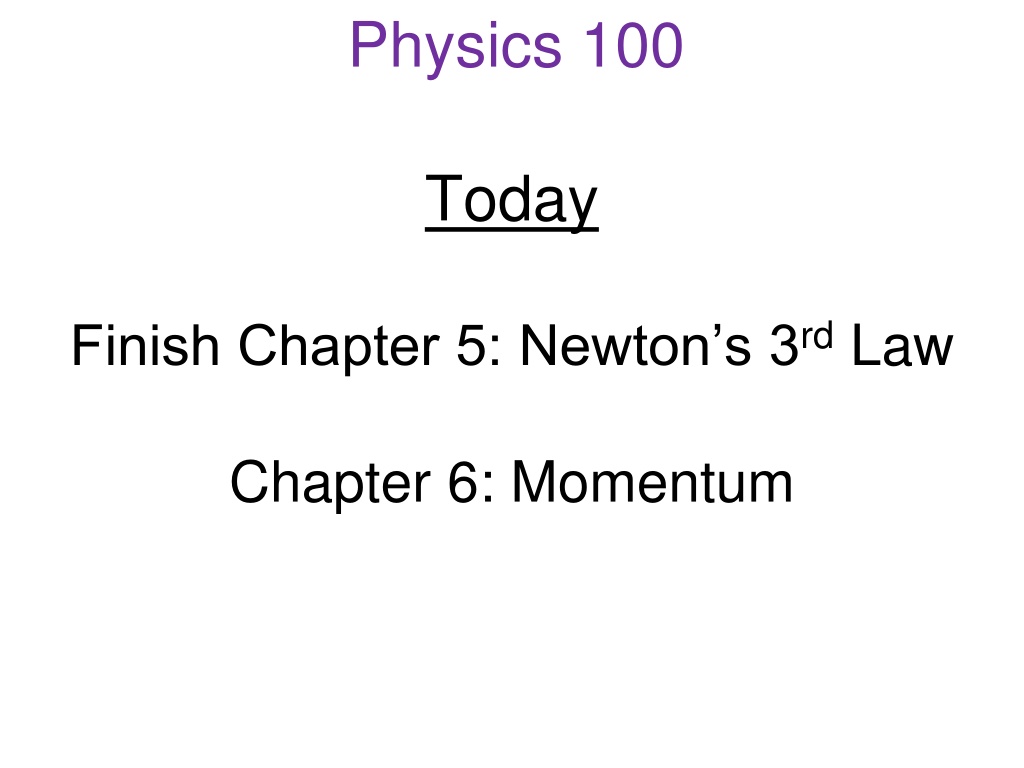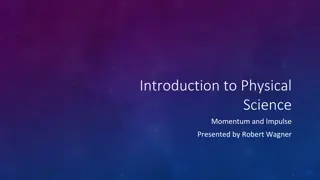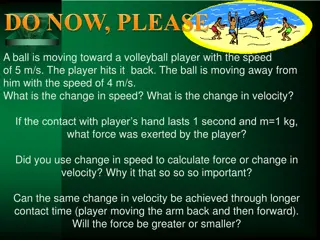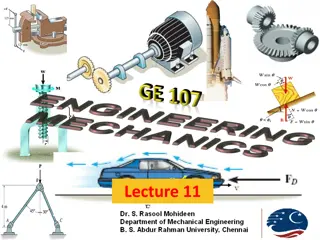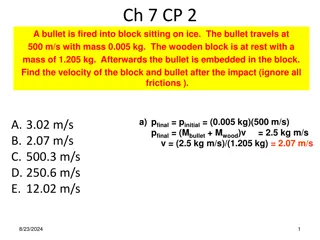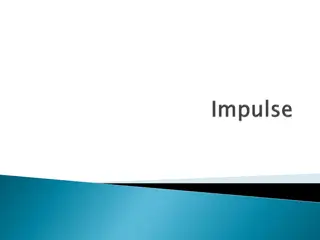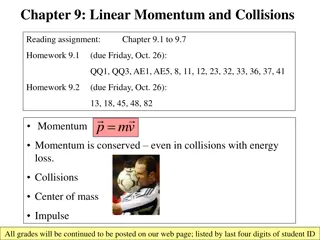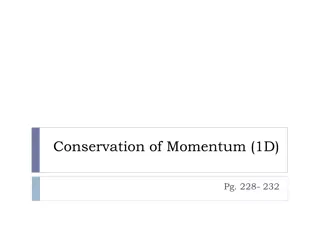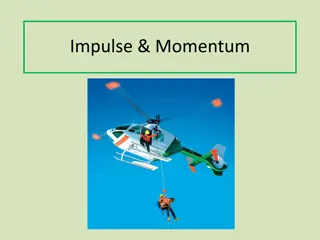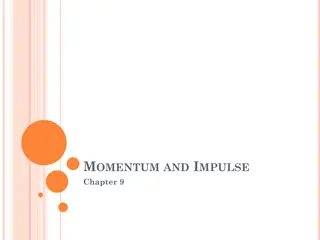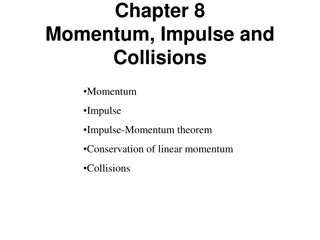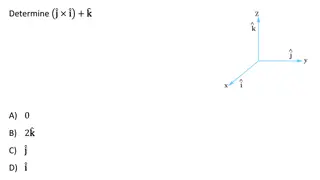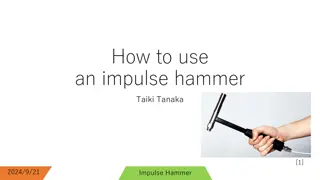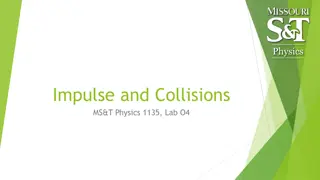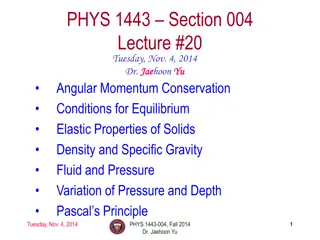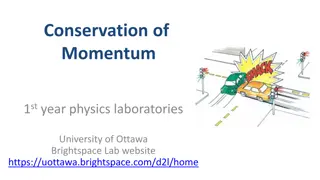Understanding Momentum and Impulse in Physics
Momentum, defined as mass x velocity, and impulse, the change in momentum resulting from a force over time, are essential concepts in physics. This chapter explores how momentum can be altered through changes in mass or velocity and how impulse affects momentum. The relationship between force, time, and momentum is examined, illustrating scenarios where maximizing or minimizing the time of interaction can alter an object's momentum effectively.
Download Presentation

Please find below an Image/Link to download the presentation.
The content on the website is provided AS IS for your information and personal use only. It may not be sold, licensed, or shared on other websites without obtaining consent from the author. Download presentation by click this link. If you encounter any issues during the download, it is possible that the publisher has removed the file from their server.
E N D
Presentation Transcript
Physics 100 Today Finish Chapter 5: Newton s 3rdLaw Chapter 6: Momentum
Momentum = inertia in motion Specifically, momentum = mass x velocity = m v Eg. Just as a truck and a roller skate have different inertia, when they are moving, they (generally) have different momenta. Question: (i) Does the truck always have more inertia than the roller skate? (ii) What about momentum? (i) Yes (mass larger) (ii) No e.g. a roller skate rolling has more momentum than stationary truck. Momentum depends on speed as well as mass .
Clicker question Which of the following has the largest momentum relative to Earth? A) A tightrope walker crossing Niagara Falls B) A pickup truck speeding along a highway C) A Mack truck parked in a parking lot D) The science building on campus E) A dog running down the street Answer: B Momentum = m v Anything stationary has zero momentum.
Impulse How can the momentum of an object be changed? By changing its mass, or, more usually, its velocity i.e. by causing an acceleration. What causes acceleration? A force But the time over which the force acts, is also important e.g. If trying to get a broken down car moving, and you push tremendously but only for a split-second, it won t move. You need to exert the force for a longer time.
Impulse cont. The effectiveness of the force in causing a change in momentum is called the impulse: Impulse = force x time-interval = F t How exactly is the momentum changed? Use N s 2nd law, a = F/m, or, F =ma. So, impulse = ma t = m (change in velocity/time) time = m (change in velocity) i.e. impulse = change in momentum Ft = (mv)
Using the impulse-momentum relation Increasing momentum As highlighted by the broken-down car example, need to apply large force for a large time. E.g. The longer the barrel of a cannon, the greater the speed of the emerging cannonball because the forces on it from the expanding gasses have more time to act. E.g. Why does an archer pull his arrow all the way back before releasing it? To give more time for the (time-varying) elastic force of the bow to act, so imparting greater momentum.
Decreasing momentum over a long time Often you want to reduce the momentum of an object to zero but with minimal impact force (or injury). try to maximize the time of the interaction (recall Ft = (momentum)) Eg. Riding with the punch, when boxing, rather than moving into it Here, by moving into the glove, he is lessening the time of contact, leading to a greater force, a bigger ouch! Here, by moving away, the time of contact is extended, so force is less than if he hadn t moved.
Decreasing momentum over a long time more examples: E.g. Car crash on a highway, where there s either a concrete wall or a barbed-wire fence to crash into. Which to choose? Naturally, the wire fence your momentum will be decreased by the same amount, so the impulse to stop you is the same, but with the wire fence, you extend the time of impact, so decrease the force. i.e. same (mv), same (Ft), but longer t and smaller F E.g. Bend your knees when you jump down from high! Try keeping your knees stiff while landing it hurts! (only try for a small jump, otherwise you could get injured ) Bending the knees extends the time for momentum to go to zero, by about 10-20 times, so forces are 10-20 times less. E.g. Try dropping an egg into a suspended cloth, rather than hitting the floor. E.g. Catching a ball tend to let your hand move backward with the ball after contact
Clicker Question Why do acrobats usually use safety nets? A) B) C) Because the overall change in momentum is less Because the overall change in momentum is greater Because falling into a safety net increases impact time compared to falling to floor, so less impulse is felt Because falling into a safety net increases impact time compared to falling to floor, so less force is felt More than one of the above is true D) E) Answer: D The impulse is the change in momentum, which is however fast the acrobat was going before (s)he came to rest. So this isn t changed by a safety net. The net increases the time for this change in momentum to occur, and since this change = impulse = F t, this means F is less.
Questions a) Is the impulse to stop a 10 kg bowling ball moving at 6 m/s less, greater or the same, if it is done in 1s rather than 2s? Same, since impulse = change in momentum is the same whatever the time it takes. b) Is the force you must exert to stop it less, greater, or the same, if done in 1s or 2s? Twice as great force if you do it in 1s than if you do it in 2s, because change in momentum = impulse = F t. (so half t means twice F) c) In a general situation, when does impulse equal momentum? If the object s initial momentum is zero, then 0 impulse = momentum change = final mom. initial mom. = final mom. Likewise, if object is brought to rest, then impulse = - initial momentum.
Decreasing momentum over a short time On the other hand, sometimes you want to obtain large forces when decreasing momentum. Want short impact times. Eg. This is how in karate (tae kwon do), an expert can break a stack of bricks with a blow of a hand: Bring in arm with tremendous speed, i.e. large momentum, that is quickly reduced on impact with the bricks. The shorter the time, the larger the force on the bricks.
Bouncing Why is it that if the expert makes her hand bounce back upon impact, she can increase the force on the bricks? Because, bouncing means reversing of momentum, so even greater momentum change. Eg. Say a 1-kg object at 1-m/s comes to rest. Then (mom) = 0 -1 kg m/s = -1 kg m/s Say instead it bounces back at 1 m/s. The change in momentum is then -1-(1) =-2kg m/s (Don t be fazed by the signs, they just indicate direction the point is that the size of the change is larger in the bouncing case)
Momentum conservation First distinguish: internal forces vs external forces on system Are interactions within the system Are interactions with objects not part of system Eg. For baseball, molecular forces holding ball together Eg. Bat s hit on the ball is external to the ball Eg. System of two skaters: the forces between the skaters are internal Eg. For system of two skaters, external forces are gravity, and support force of ice So, what is internal and what is external depends on what we choose to include in the system. To change the system s momentum, need a net external force (from 2nd law) Equivalently, if no net external force, can be no momentum change. i.e. momentum is conserved if Fnet,ext = 0.
Eg. Skating When the larger man (M) pushes the smaller boy (m) on a frictionless surface, there are no net external forces, so momentum of the system (man + boy) does not change. Force on m is equal and opposite to force on M (3rd law). The two forces act for the same time same impulse to each, but in opposite direction same change in momentum for M as for m, but in the opposite direction i.e. the momentum changes for the system cancel to zero. Momentum is conserved. M v = - m V Both the boy and the man gain considerable momentum, but the (man + boy) system experiences zero momentum change. Note: -- importance of direction (as well as size), when considering momentum. -- momentum conservation closely related to N s 3rd Law (action-reaction)
Whenever an interaction occurs in a system, forces occur in equal and opposite pairs. Which of the following do not always occur in equal and opposite pairs? 1. Impulses. 2. Accelerations. 3. Momentum changes. 4. All of these occur in equal and opposite pairs. 5. None of these do.
Whenever an interaction occurs in a system, forces occur in equal and opposite pairs. Which of the following do not always occur in equal and opposite pairs? 1. Impulses. 2. Accelerations. 3. Momentum changes. 4. All of these occur in equal and opposite pairs. 5. None of these do. Answer: 2 Because time for each interaction part is the same, impulses and momentum changes also occur in equal and opposite pairs. But not necessarily accelerations, because the masses of the interaction may differ. Consider equal and opposite forces acting on masses of different magnitude. F m= a m=a F
Happen fast enough that can neglect any other force acting on the system during the collision Collisions of system of colliding objects Momentum is conserved during a collision, because all forces acting in collision are internal to the system of colliding objects: Net momentum before collision = net momentum after collision Momentum is redistributed among the participants of the collision. Example: Two equal-mass balls colliding: a) The moving ball comes to rest, the other moves off with the speed of the colliding ball. b) Head-on collision each ball reverses its momentum pi = p1 pi = p p = 0 pi = -p+p = 0 pf = p2 = pi
Collisions of system of colliding objects Momentum is conserved during a collision, because all forces acting in collision are internal: Net momentum before collision = net momentum after collision Momentum is redistributed among the participants of the collision. Example: Two equal-mass balls colliding: b) Head-on collision each ball reverses its momentum a) The moving ball comes to rest, the other moves off with the speed of the colliding ball. pi = p1 pi = p p = 0 pi = -p+p = 0 pf = p2 = pi These are both elastic collisions no lasting deformation or heat or sound
Many collisions are inelastic - where heat and/or sound is generated, and/or objects deform. Even so, momentum is still conserved . Eg. Note that net momentum before = net momentum after (always in collision, whether elastic or inelastic)
Clicker Question A garbage truck and a mini car have a head-on collision. Which vehicle experiences the greater force of impact? A) Both same B) The garbage truck C) The mini-car D) Impossible to say without more information Answer: A From Newton s 3rd Law of action-reaction. Again, distinguish force from effect of force!
More Questions In the head-on collision between the garbage truck and a mini car: a) Which experiences the greater impulse? Both same (same force over same time interval) b) Which experiences the greater momentum change? Both same (momentum of system conserved, so momentum change of truck is equal and opposite to the momentum change of the car) c) Which experiences the greater acceleration? The car (smaller mass)
Questions continued d) Say the garbage truck weighs 15 000-kg, and the mini car weighs 1000 kg. Let s say the truck is initially moving at 30 km/h and the car is at 60 km/h. If the two stick together after the collision, then what is their speed after the head-on collision? Momentum conservation means: mom. of truck before + mom. of car before = mom of (car+truck) after i.e. mt vt - mc vc= (mt+mc) v (- on left because opp dir) (15000)(30) - (1000)(60) = (16000) v So, v = 24.375 km/h Note that they do eventually come to rest because of friction on the road an external force. Since the impact time is relatively short, we can ignore this external force during the collision since it is much smaller than the collisional impact force. Hence we assume momentum is conserved in the collision.
Another Question The orange fish has mass 4-kg, and the purple one has mass 1-kg. a) If the orange fish is swimming at 2 m/s towards the purple fish at rest, what is the speed of orange fish after he swallows him? Neglect water resistance. Net momentum before = net momentum afterwards (4 kg)(2 m/s) + (1 kg)(0) = ((4+1)kg) v 8 kg m/s = (5 kg) v . So v = 8/5 m/s = 1.6 m/s b) If instead the purple fish sees the orange fish coming, and swims away at 1m/s, then what is the speed of the orange fish, after he catches up and swallows him? (4 kg)(2 m/s) + (1kg)(1m/s) = ((4+1)kg) v Net momentum before = net momentum afterwards 9 kg m/s = (5 kg) v . So v = 9/5 m/s = 1.8 m/s
Collisions in more than 1dimension The net momentum in any direction still remains unchanged. Need to use parallelogram rule to figure out net momentum vector. We ll just look at some simpler cases Eg. Car A traveling down Lexington Ave at 40 mph, crashes with Car B traveling down 68th St also at 40 mph, and stick together. Which direction do they move off in and at what speed (initially)? The diagonal of square has length times length of one side. So here, the resultant speed is 40 mph = 56.6 mph. Direction is north-east in picture shown, i.e. at 45 degrees to both Lexington and 68th St.
Eg. Firecracker exploding as it is falling, (or a radioactive nucleus breaking up..) Momenta of final fragments add to give net momentum equal to the initial. Eg. Billiard balls ball A strikes B which was initially at rest. Parallelogram with A and B gives original momentum of A.
Clicker Question If all people, animals, trains and trucks all over the world began to walk or run towards the east, then the Note: you may need to know which way the earth spins! Realize that the sun rises in the east and sets in the west A) earth would spin a bit faster B) earth would spin a bit slower C) earth s spin would not be affected at all Answer: B The total momentum of people etc + earth must remain the same because there is no change in the external force the running to the east is an internal force to the people + earth system. Since the people gain momentum to the east, then the earth must lose momentum in the east direction, therefore it spins a bit slower. (Note that the earth spins towards the east)
Clicker Question If while floating in outer space you take your shoe off and throw it away, you and the shoe will A) move away from each other, but at different speeds B) move away from each other at the same speed C) move a short distance and then slow down D) move a short distance and then go faster Answer: A The total momentum of you + shoe is conserved, so your change in momentum is equal and opposite to the change in momentum of the shoe. Since the shoe weighs less, its speed is higher.
